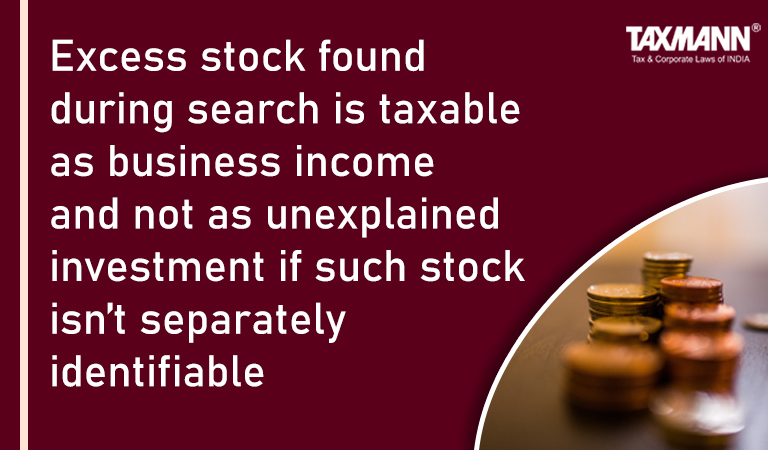Excess stock found during search is taxable as business income and not as unexplained investment if such stock isn’t separately identifiable
- Blog|News|Income Tax|
- 2 Min Read
- By Taxmann
- |
- Last Updated on 22 November, 2021

Case details: PPCIT v. Deccan Jewellera (P.) Ltd. - [2021] 132 taxmann.com 73 (Andhra Pradesh)
Judiciary and Counsel Details
-
- Joymalya Bagchi and K. Suresh Reddy, JJ.
Facts of the Case
Assessee was engaged in the business of gold and diamond jewellery and silver articles. A search and seizure operation under section 132 was conducted on assessee and its group concern. During the search, the assessee declared excess stock. It was submitted that such excess stock was the result of suppression of profit from the business over the years. Since the assessee had not been kept it identifiable separately, investment in excess stock had to be treated as business income.
Assessing Officer (AO) duly considered and accepted such explanation and taxed additional income as ‘business income’ at 30 percent, which the Joint Commissioner approved. However, later the Principal Commissioner (PPCIT) invoked revisional powers under section 263 purportedly on the ground that the decision of AO was erroneous and prejudicial to the interest of revenue. On appeal, the Tribunal set-aside order of PCIT. Aggrieved-PCIT filed the instant appeal before the High Court.
High Court Held
The High Court held that as per section 69, investments would fall within the definition of ‘undisclosed investment’ in the event the following conditions are satisfied:
(a) Such investment is made in the course of the financial year and not reflected in the books of account, if any, maintained by the assessee for any source of income,
(b) No explanation is offered by the assessee about the nature and source of investments, and
(c) Such explanation is not found to be satisfactory in the opinion of the Assessing Officer.
In the given case, the assessee submitted that the nature and source of the excess stock fell under the heading ‘Profits and Gains of the Business’. Further such stock was not specifically identifiable from the profits which had accumulated from earlier years. These explanations offered by the assessee were duly accepted by the AO, which came to be approved by the Joint Commissioner.
Therefore, it couldn’t be said that the condition precedents for holding that the excess stock as ‘undisclosed investment’ under section 69 was satisfied. Accordingly, the revisional powers were illegally invoked by the PCIT, and his order was rightly set aside by the Tribunal.
List of Cases Referred to
-
- Chokshi Hiralal Moganlal v. Dy. CIT [2011] 9 taxmann.com 300/45 SOT 349 (Ahd. – Trib.) (para 8)
- Asstt. CIT v. Sanjay Bairathi Gems Ltd. [2017] 84 taxmann.com 138/166 ITD 445 (Jp. – Trib.) (para 8)
- Dy. CIT v. Ram Narayan Birla [IT Appeal No. 482 (Jp.) of 2015, dated 30-9-2016] (para 8)
- Kim Pharma (P.) Ltd. v. CIT [2013] 35 taxmann.com 456/216 Taxman 153 (Punj. & Har.) (Mag.) (para 8)
- CIT v. S.K. Srigiri & Bros. [2008] 171 Taxman 264/298 ITR 13 (Kar.) (para 8)
- Spectra Shares & Scrips (P.) Ltd. v. CIT [2013] 36 taxmann.com 348/219 Taxman 61 (Mag.)/354 ITR 35 (AP) (para 19)
Disclaimer: The content/information published on the website is only for general information of the user and shall not be construed as legal advice. While the Taxmann has exercised reasonable efforts to ensure the veracity of information/content published, Taxmann shall be under no liability in any manner whatsoever for incorrect information, if any.

Taxmann Publications has a dedicated in-house Research & Editorial Team. This team consists of a team of Chartered Accountants, Company Secretaries, and Lawyers. This team works under the guidance and supervision of editor-in-chief Mr Rakesh Bhargava.
The Research and Editorial Team is responsible for developing reliable and accurate content for the readers. The team follows the six-sigma approach to achieve the benchmark of zero error in its publications and research platforms. The team ensures that the following publication guidelines are thoroughly followed while developing the content:
- The statutory material is obtained only from the authorized and reliable sources
- All the latest developments in the judicial and legislative fields are covered
- Prepare the analytical write-ups on current, controversial, and important issues to help the readers to understand the concept and its implications
- Every content published by Taxmann is complete, accurate and lucid
- All evidence-based statements are supported with proper reference to Section, Circular No., Notification No. or citations
- The golden rules of grammar, style and consistency are thoroughly followed
- Font and size that’s easy to read and remain consistent across all imprint and digital publications are applied




